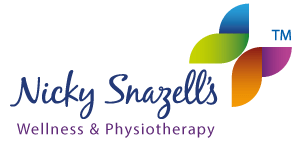As we watch the war in Ukraine, with its ongoing devastation and atrocities, it’s inevitable that we will become numbed to the never ending bad news being delivered to us every day. Luckily for us, the war can be turned off with the touch of a button.
But for Ukrainians it’s real and it’s there 24/7.
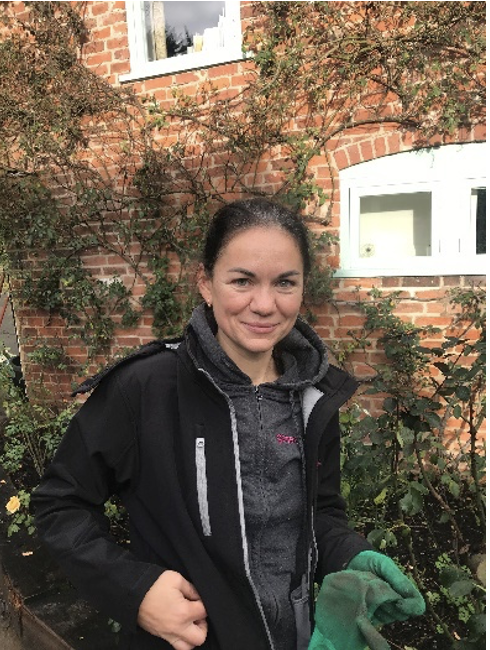 The implications of that reality came close to home, when I met one of the team who helps look after our grounds. Alina was a Professor of Mathematics in her home town of Zaporizhzhya when Russia invaded. Her family of husband and two daughters had to make what must have been a terrifying decision of splitting the family, so that Alina could escape and get their daughters to safety, while her husband stayed behind to help the fight.
The implications of that reality came close to home, when I met one of the team who helps look after our grounds. Alina was a Professor of Mathematics in her home town of Zaporizhzhya when Russia invaded. Her family of husband and two daughters had to make what must have been a terrifying decision of splitting the family, so that Alina could escape and get their daughters to safety, while her husband stayed behind to help the fight.
You Can Also Help
Whilst we are facing some tough times in the UK, it’s nothing in comparison to what the average Ukrainian is facing every day with bombs and missiles falling and devastation left behind. That’s why we decided to help Ukraine with monthly donations from the clinic. In addition, we decided to have a special offer on all of Nicky’s books and the bespoke sterling silver jewellery, with 100% of the revenue going to help the people and animals suffering in Ukraine.
These Items Are Being Sold Below Cost
Both Nicky’s books and the bespoke silver jewellery would make an excellent gift for Christmas, or why not just treat yourself?
We guarantee 100% of the money paid for the books or jewellery
will go to support Ukraine.
One of the first questions any patient asks when obtaining an injury is ‘how long until it gets better’... If only an answer were simple.
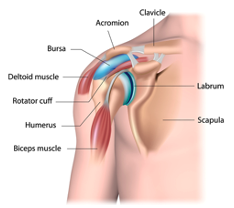
Unfortunately, when it comes to the shoulder joint, the answer isn’t straightforward at all because your shoulder is one of the most complicated joints in your body.
To achieve the wide range of movement that the shoulder provides, it requires a combination of muscles from body to shoulder blade (scapula), body to arm bone (humerus) and shoulder blade to arm bone. Due to this complexity, it is one of the most susceptible joints in the body to injury.
The shoulder is made up of three bones, the upper arm bone (humerus), the shoulder blade (scapula) and the collarbone (clavicle). There are joints between the clavicle and scapula and between the scapula and humerus.
The stability of the shoulder is predominantly controlled by four muscles, commonly known as the rotator cuff. They are tasked with keeping the joint properly centred and located.
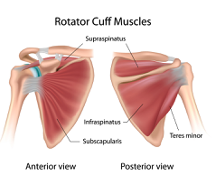 These are
These are
- Supraspinatus
- Infraspinatus
- Subscapularis
- Teres Minor
Common Shoulder Problems
The most common shoulder injuries are:
- Rotator cuff tears/tendonitis
- Impingement
- Instability
- Frozen Shoulder
- Bursitis
- Osteoarthritis
Rotator Cuff Tears
The rotator cuff muscles and tendons are an important part of the shoulder and are tasked with keeping the bones of the joint together across its wide range of motion. Rotator cuff tears account for more than 50% of shoulder injuries and are most common in people who repeatedly perform overhead motions. Thus athletes involved in sports such as swimming, racquet sports and weight lifting, which all require repetitive overhead movement, are particularly prone to injury.
Typical symptoms of a rotator cuff tear will be pain at night disturbing your sleep, and probably some lessening of pain during the day, although any overhead movement or even reaching behind your back is likely to be painful. You will also probably experience weakness in the affected arm. If left untreated, the pain will most likely increase over time.
Keen athletes may be tempted to continue in their favourite sport, in the hope that the pain will recede, but this will most likely aggravate the situation and, over time, may make the condition worse. If you suspect a rotator cuff tear, it is strongly advised to seek help from a qualified physiotherapist or sports therapist as soon as possible, as some conditions, such as a full-thickness supraspinatus tear, can become irreversible if left too long.
Impingement
Rotator cuff tendons can become trapped between a bony projection of the shoulder blade called the acromion and the top of the humerus (arm bone). Particularly prone is the supraspinatus tendon, this muscle is responsible for moving the top of the arm sideways from the body for about the first 15 degrees of arm movement.
Impingement problems can be caused by a number of factors, including:
- Loss of scapula – humeral rhythm
- Nerve interference or injury from the neck to the shoulder, causing abnormal movement of the shoulder
- Poor posture
- Tears and inflammation of tendons
Instability
Recent dislocation, sudden injury or overuse can each cause shoulder instability. The head of the upper arm bone can glide out of the shoulder socket (glenoid). This can occur when the capsule and ligaments that have the role of stabilising the shoulder in the socket have not healed properly and remain stretched making them too loose to keep the shoulder stabilised. This can result in repeated dislocations.
It is, therefore important to seek treatment. Rehabilitation and soft tissue work can be provided by qualified physiotherapists or sports therapists to help strengthen the muscles and ligaments and help to gain stability around the shoulder joint once more. It is advisable to seek help sooner rather than later.
Frozen Shoulder
This condition, medically described as adhesive capsulitis, can literally develop overnight. The capsule of the joint becomes inflamed and stiff, resulting in restricted movement. Eventually, the shoulder ‘freezes’ and becomes immobile for a few months to a year.
However, a frozen shoulder does typically progress in three main stages:
- Freezing stage- any movement of your shoulder causes pain, and your shoulder's range of motion starts to become limited.
- Frozen stage- pain may begin to diminish during this stage. However, your shoulder becomes stiffer and moving it becomes more difficult.
- Thawing stage- The range of motion in your shoulder begins to improve.
Bursitis
A bursa is a fluid-filled sac that act as a cushion to stop friction between the muscles and bones as they glide over on another. You have several in your shoulder, one being one of the largest in the body which is located towards the top of the arm.
After an excessive repetitive motion of the shoulder, the bursas can inflame and swell. The pain is normally a gradual onset located on the outside of the shoulder which can spread down the arm. It can become more aggravated when lying on the shoulder or if you’re using your shoulder anywhere from 60-90 degrees up and outwards.
When treating Bursitis, the aim is to control the inflammation. If you don’t seek help, often the pain will become worse and become impinged.
Osteoarthritis
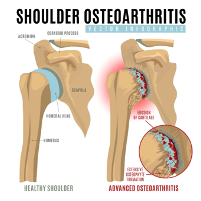 This is when the normally smooth cartilage that covers the ball and socket joint diminishes after constant friction leaving bone to grind against bone. It develops slowly and the pain worsens over time, normally after chronic wear and tear or work injuries. Symptoms may include swelling, pain, and stiffness.
This is when the normally smooth cartilage that covers the ball and socket joint diminishes after constant friction leaving bone to grind against bone. It develops slowly and the pain worsens over time, normally after chronic wear and tear or work injuries. Symptoms may include swelling, pain, and stiffness.
Osteoarthritis is a chronic problem which cannot be resolved, but the symptoms of the condition are amenable to pain-reducing treatment.
Every shoulder injury will present differently, and everyone’s perception of improvement will be different too. For example, one patient may be over the moon for gaining an extra 10 degrees in pain-free shoulder motion. Whereas the next will be happy only when gaining their full range of motion back.
Many biological, psychological, and social factors are involved during the recovery process after a shoulder injury.
If you are suffering from shoulder pain, we can help
Call 01889 881488 Now
Jean, Erica & Charlotte will be happy to help
The knee is the body’s largest joint and made up of four bones; the shin bone (tibia), the thigh bone (femur), a smaller bone on the outside of the leg (fibula) that attaches to the shin bone and helps support body weight, and the knee cap (patella). The knee joint is called a hinge joint, as it can bend, straighten and twist.
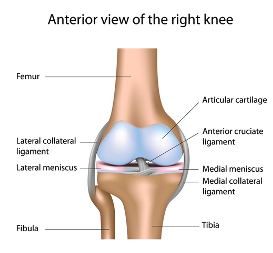
Each of the ends of the bones in the knee are covered in cartilage to protect the bones and let the joint move smoothly. Between the bones in the knee, there are 2 wedge-shaped pieces of cartilage, called meniscii. These are the shock absorbers and help cushion the joint from impact.
The knee joint is held together by ligaments which make the joint stable. There are four main ligaments in the knee. There are the collateral ligaments which run down the sides of the knee, which help to limit sideways movement of the joint and support against unusual movement. Then there are the cruciate ligaments, which are inside the knee and cross each other, to control back and forth movement in the joint.
Another factor in knee stability is muscles which also provide power and are the reason the joints can move. The knee is surrounded by strong muscles. The quadriceps are the front thigh muscles and they work to straighten the knee. If they are weak then this can lead to instability of the knee and kneecap. The hamstrings are the muscles on the back of the leg and their job is to bend the knee.
Which are inside the knee and cross each other, to control back-and-forth movement in the joint.
Another factor in knee stability is muscles which also provide power and are the reason the joints can move. The knee is surrounded by strong muscles. The quadriceps are the front thigh muscles and they work to straighten the knee. If they are weak then this can lead to instability of the knee and kneecap. The hamstrings are the muscles on the back of the leg and their job is to bend the knee.
Common knee injuries/conditions:
Knee ligament injuries – Normally from an accident, whether a slip, trip or fall. As mentioned above there are several different ligaments that support the knee. If you think you may have injured one, it is important that you see a Physiotherapist/Sports Therapist who can examine your knee to diagnose which ligament is damaged and how badly.
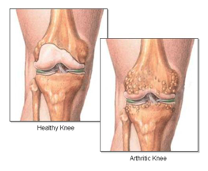 Osteoarthritis - wear and tear of the cartilage in the knee is called Osteoarthritis and is a common cause of pain. It may be aggravated by biomechanics, previous injury, overuse or the simple effect of years of living. Osteoarthritis symptoms can be relieved with orthotics, exercise and pain-relieving treatments.
Osteoarthritis - wear and tear of the cartilage in the knee is called Osteoarthritis and is a common cause of pain. It may be aggravated by biomechanics, previous injury, overuse or the simple effect of years of living. Osteoarthritis symptoms can be relieved with orthotics, exercise and pain-relieving treatments.
Cartilage injuries – often caused by sudden twisting, the cartilage between the knee can get damaged. If this is the case the knee needs strengthening and there may be a chance that surgery is required. It is crucial that you have a proper assessment to determine the best course of action.
The Impact of Leverage
When we can’t undo a tight nut, we reach for a longer spanner to give us more leverage. It’s a concept we all understand.
This same leverage principle applies to our knees as well because for most of the time the centre of our weight is not directly over our knees. Try looking sideways in a mirror and bend your knees and you will see that your knees are in front of the trunk of your body. Hence your body weight is applying leverage on your knees. As you bend your knees further, your knees get further in front and the leverage increases, just like using a longer spanner.
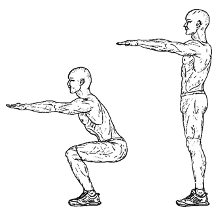
The implications of this leverage are that in normal walking your knees have to support 4 times your weight. If you crouch down it can go as 9 times your weight. No wonder then that if we carry excess weight, our knees will take the brunt of that, which means that knee problems are likely to be more likely with excess weight.
The good news is that most of us have the capability to do something about our weight. A simple change in diet and a bit more exercise is all it usually takes. And, of course, the motivation to do this.
Most common knee injuries in sports
The knees are frequently injured due to the stress of frequent starts, stops, twists and turns applied to the joint during exercise.
- The most common injury in the knee is knee ligament injuries. This normally occurs from an accident, whether a slip, trip or fall. The ligaments’ main role is to stabilise the knee so the knee might experience a sudden twisting motion, a rapid change in direction, or an incorrect landing from a jump. Sometimes you can hear a pop, or a snap followed by swelling and a loss of range of motion. It is important to see a physiotherapist/ sports therapist who can examine your knee to diagnose which ligament is damaged and how badly, so we can treat it sooner rather than later.
- Another common injury is to the meniscus (shock absorbers) of the knee. This can happen from general aging where the meniscus has become weak and tears after an awkward turn during normal day to day activities. Or it can happen during sports where the knee twists and pivots. You will normally feel pain, stiffness, locking and a decreased range of motion.
- Meniscus damage can take time to heal and can get worse over time if it isn’t treated properly by a physiotherapist/ sports therapist. It is crucial to have a proper assessment to determine the best course of action.
Overuse injuries are also common, including ‘runners’ knee’ or osteoarthritis.
- Runner’s knee is common in runners and cyclists. You often have dull pain around the front of the knee and can feel like a rubbing, grinding, or clicking sound in the knee cap. Your physiotherapist/sports therapist can help treat runners’ knee through a combination of massage and acupuncture. This will help relieve some of the pain and break that vicious cycle.
Looking after yourself and keeping healthy will most likely keep knees healthy too. Getting help sooner rather than later will also help massively with recovery time and getting you back to your day-to-day pain free activities.
If you are suffering with knee problems, you really need to see a physiotherapist/sports therapist sooner rather than later to correctly diagnose and then provide the best treatment possible.
Call 01889 881488 Now
Erica, Jean and Charlotte will be happy to help
The elbow joint is a synovial hinge joint in the arm and consists of three main bones: The humerus of the upper arm, the radius and ulna of the forearm. The elbow joint enables us to bend and straighten our arm.
Tennis Elbow
This is a condition that causes pain on the outside of your elbow. It is mostly caused by overusing your forearm from repetitive or strenuous motions. If these motions are a normal part of your daily routine, then resolving your tennis elbow pain can involve quite a lot of time and treatment. In the interim, you may only get bouts of temporary relief. Permanent relief will probably necessitate a change in your daily routine and a fair degree of patience. Needless to say, tennis elbow problems should always be referred to qualified therapists with access to suitable technology, such as shockwave.
A simple but effective exercise involves doing light twists of the arm and bicep curls using a lightweight. The goal is to strengthen the tendons and the muscles in you arm. You can also stretch out the forearm by placing your fingers on a hard surface and pressing downwards, stretching out both the hands, the wrists, and the forearms.
Self-massage can also be helpful and can be found on YouTube. We also offer sports massage therapies in the clinic, ask for details
Golfers Elbow
Now the difference between tennis elbow and golfers’ elbow is that tennis elbow is inflammation of the tendon where it joins to the bone in the outer elbow and golfers elbow is inflammation of the tendon where it joins to a bone in the inner elbow.
Both injuries are overuse injuries that are caused by activities that require repetitive motion of the arm and wrist. The problems of resolving pain from golfers elbow are the same as for tennis elbow, covered above.
Occasionally, for both golfers and tennis elbow you may wear an elbow brace. The purpose of the brace is to redirect the pressure over your muscles so that the injured area doesn’t take full force.
Bursitis
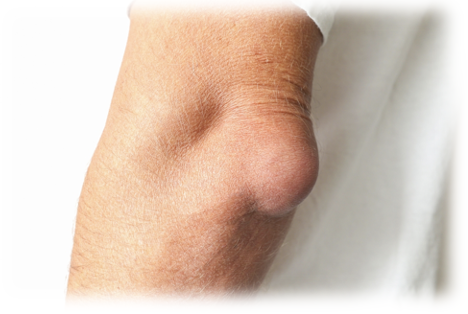 There are many bursae located throughout the body that act as cushions between bones and soft tissues, such as skin. They contain a small amount of lubricating fluid that allows the soft tissues to move freely over the underlying bone.
There are many bursae located throughout the body that act as cushions between bones and soft tissues, such as skin. They contain a small amount of lubricating fluid that allows the soft tissues to move freely over the underlying bone.
Sometimes the bursa may become irritated or inflamed, more fluid will accumulate in the bursa and a bursitis will develop. It becomes swollen, painful and worsens with direct pressure on to the elbow. The swelling can sometimes grow large enough to effect range of motion. It can also become red and warm to touch.
At Nicky Snazell’s clinic, you can receive two treatments for bursitis that will help alleviate acute and chronic pain. Deep oscillation and pulsed shortwave.
- Deep oscillation provides an electrostatic current that helps to increase blood flow, circulation and helps to enhance treatment outcomes as it proves symptomatic relief.
- Pulsed shortwave acts as a type of microwave that provides a high frequency electromatic energy into the body to help reduce pain and swelling. It works particularly well for bursitis.
A soft pad can ease discomfort.
Ulna nerve irritation
This occurs when the nerve in the arm becomes compressed or irritated. The ulna nerve is one of the three main nerves in the arm. It travels from your neck down into your hand and can be constricted in several places along the way.
The most common place for compression of the nerve is behind the inside part of the elbow. Ulnar nerve compression at the elbow is called ‘cubital tunnel syndrome. It can cause numbness and tingling sensations in the hand and fingers.
However, you should seek help from a therapist as there are a number of reasons you may be getting these symptoms. More often than not, the pins and needles sensation you may feel, in your hand, for example, can be coming from a different area of the body completely. It may just be referred pain you are experiencing.
Top tips to reduce the likelihood of elbow injury
- Seek early advice from a physiotherapist or sports therapist.
- Protect your joints during activity, especially during winter activities. Wear elbow pads and wrist guards
- Don’t throw through elbow pain.
- Maintain a good posture- this prevents elbow injuries from compensatory overuse.
- Consider a workstation set up, as elbow pain can develop with prolonged daily computer use with poor posture.
If you are in pain, we can help
Call 01889 881488 Now
Jean, Erica & Charlotte will be happy to help
A lot of you may have watched the commonwealth games this year and noticed a familiar location that the mountain bikers raced on. Cannock Chase has provided us with the opportunity to use this track whether to practice or cycle on for the experience. Whether you are interested in mountain biking over Cannock Chase, or road cycling and you want to do so while minimising your chances of injury, then here is some free advice given to you from our sports therapists at Nicky Snazell’s Wellness and Physiotherapy Clinic.
First, there are many ways to decrease your chance of injury and footwear is one factor you should consider.
Compared to running shoes, cycling shoes are designed with stiffer soles to help optimize your energy transfer. You should keep your foot rigid, so there’s no power lost through your feet and all the power from your legs goes directly into the pedal stroke. Additional support from clipping your shoes into your road bike will also help you to feel more secure when you are pedalling and can help prevent you from losing balance. It can also make you more aerodynamic as it has been noted that it is easier to get your torso lower toward your handlebars making you more streamlined increasing your speed.
That said, proper trainers are only part of the solution if you are struggling with any pain when cycling. Strengthening and conditioning the muscles in your legs and core region is essential for injury prevention. We can provide guidance, not only to stop and prevent pain occurring but to increase your cycling longevity and your performance.

What are the most common injury areas from Cycling?
The most common injury areas, more often due to overuse and poor technique are:
- Knee
- Lower back
- Neck
- Thigh
- Ankle
Specific diagnoses for these areas are:
- Anterior knee pain
- Lumbar or neck myofascial pain, a chronic condition affecting the muscles
- The iliotibial band running up the outside of the thigh
- Achilles tendonitis
If you are a keen cyclist, the chances are you have suffered from an injury throughout your training. Understanding how and why this is caused and taking steps to strengthen your weakness could be a game-changer for your performance.
Strength and Conditioning
The problem for many of us is that daily life can involve a lot of sitting at a computer screen all day and this can lead to poor posture and the important muscles in our trunk stiffening up and weakening. These core muscles, along with those in the buttocks and thigh are important tant in stabilising you during exercise. If these muscles become weak you are more likely to injure yourself from falls or strains.
What is Strength and conditioning?
The use of dynamic and static bodyweight and resistance exercises to improve your performance and reduce the likelihood of injury occurring. It is also used during injury recovery.
Why should I strength and condition?
- Injury prevention – helps to correct muscle imbalances and improve muscle activation, as well as increasing the efficiency of your running biomechanics which results in improved running performance.
- To be faster/ stronger
- To enjoy exercise more.
If this sounds like something you may need, book an appointment with one of our sports therapists to get the best possible guidance and treatment. As an athlete, you put so much effort into your training, it’s worth putting the effort into taking care of your body too. Prevention is just as important as recovery.
Call 01889 881488 Now
Erica, Jean and Charlotte will be happy to help
Whether you are interested in the Cannock Chase 10k, a park run or even the Stafford half marathon, and you want to do so while minimising your chances of injury, then here is some free advice given to you from our sports therapists at Nicky Snazell’s Wellness and Physiotherapy Clinic.
First, though there are many ways to decrease your chance of injury, and footwear is one of the most important and there are a few important factors you may want to consider.
You may have just bought your first pair of trainers or have thousands of miles underfoot; either way, it is important to make sure they have good support. This is because the feet play a critical role in absorbing your body weight and the force of impact when you run or walk.
For example, when you run, your momentum generates a lot of force (up to 5X your body weight). Each time the foot strikes the ground, your joints absorb the impact. The shock from this force is felt in the feet and travels up the spine. This can lead to stress and strain on the joints and can lead to injury over time. Some factors to consider when buying a trainer.
- Ensure your trainer has a thicker heel to absorb impact. The build of the shoe will give you longevity and the cushion and material needed to withstand impact and repeated stress.
- It is also important to have a good structure. This will help ensure protection and support, reducing the likelihood of turning your ankle especially when going over the variety of terrain that you will experience on trail-runs.
- Making sure that the trainer is suitable for the type of running/walking you’re doing
Biomechanics & Orthotics
Even though you may have very good trainers, it’s possible that the way your foot interacts with the ground is far from optimal, which in turn can cause many problems not only in the foot and ankle but also in the knees, hips and spine, all the way to the neck. A properly prescribed bespoke orthotic based on a detailed static and dynamic assessment can resolve many of these problems, leading to fewer niggles, pain and injury in the long run.
Our sports therapists are able to provide such detailed assessments and if needed, also use this to design specific treatment plans to help your recovery.
What are common running injuries example
Ankle sprains are a common running injury. This is when ligaments that connect bone to bone in the ankle become overstretched through either rolling/twisting or over-rotating the ankle. This can happen in a split second with a simple slip on a wet tree root or a sudden shift of a rock underfoot. This may be accompanied by swelling, stiffness, and pain. While the R.I.C.E (Rest, Ice, Compression and Elevation) treatment is often an effective method to use at home, it would usually be advisable to seek help from one of our sport therapists to get the best treatment to speed up your recovery, plus get the prescription of the most appropriate strength and conditioning exercises to help stop the injury from spraining again.
Road Running VS Trail Running
Road Running
Road running is one of the most convenient forms of exercise as you can throw your shoes on and leave your house on a consistent surface. However, due to the hard surface, the vibrations going through your feet will produce greater stress on your weight-bearing joints such as your knees, hips and ankles. This will impact on those with poor tissue quality, arthritis history and those recovering from injury.
Trail Running
Running on trails is more technical due to the variety of terrain, surfaces, and hills.
As a trail runner, it is very important to have good balance and a very strong core to support your legs as they jump, dodge, and move in sudden different directions. The uneven surface and diverse terrain challenge the muscles of the lower body more than a flat, firm road. The natural obstacles can give you a more effective overall workout and help improve your sense of balance and reaction time.
Strength and Conditioning
Proper trainers and orthotics are only part of the solution if you are struggling with any pain when walking or running. Strengthening and conditioning your muscles in your legs and core region is essential to minimise injury occurrence. We can provide guidance not only to stop and prevent your pain from occurring but to increase your running longevity and your performance.
If you are a keen athlete, the chances are you have suffered from an injury throughout your training. Understanding how and why this is caused and taking steps to strengthen your weakness could be a game-changer for your performance.
The problem for many of us is that daily life can involve a lot of sitting at a computer screen for many hours and this can lead to poor posture, plus muscles in our trunk stiffening up and weakening. These core muscles, along with those in the buttocks and upper leg are important in stabilising you during exercise. If these muscles become weak, you are much more likely to injure yourself from falls or strains.
What is Strength and conditioning?
The use of dynamic and static bodyweight and resistance exercises to improve your performance and reduce the likelihood of injury occurring. It is also used during injury recovery.
Why should I strength and condition?
- Injury prevention – helps to correct muscle imbalances and improve muscle activation, as well as increasing the efficiency of your running biomechanics, which results in improved running performance.
- To be faster/ stronger
- To enjoy exercise more.
If you are suffering repeated running injuries or just niggling pain, these will prevent you from enjoying your sport as much as you would like. Our sports therapists can certainly help you both recover faster and help you minimise the chances of recurrence in the future. As an athlete, you put so much effort into your training, it’s worth putting the same effort into taking care of your body too. Ultimately, prevention is more important than recovery.
Call 01889 881488 Now
Erica, Jean and Charlotte will be happy to help.
At our clinic we have both Sports Therapists and Physiotherapists and it will probably confuse you as to why we suggest one type of therapist before the other.
Physiotherapists are trained to cover acute and chronic injuries to the structure of the body (MSK) and how to recognise the multitude of medical conditions with which they could be faced with in a hospital.
Sports Therapists are trained to deal with acute trauma, typically as would be found pitch side. In this situation at a major club, a Sports Therapist would work alongside a medical Doctor and Physiotherapist.
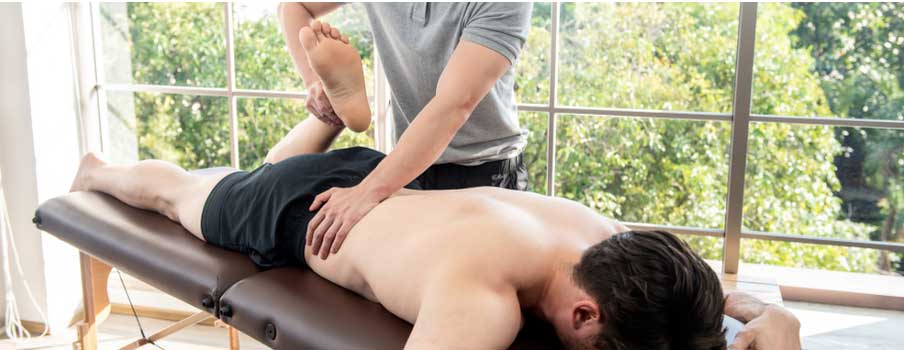
Recently I discussed roles with an Olympics Physiotherapist, and he felt Sports Therapists were excellent at pitch side care, having good relationships with the players. They would routinely deal with acute trauma and CPR. They are used to assess essentially healthy individuals with acute injury.
They can diagnose sports injuries and prescribe complex rehabilitation programs to aid recovery. They know when and how much sport to return to as the injury heals and have knowledge of massage, nutrition, preventative care and how to stay well.
Physiotherapists are not able to prescribe sports-specific rehabilitation programs unless trained postgraduate in sports medicine. They can however triage sports injuries, head injuries, spinal problems, neurological problems, and respiratory and rheumatological problems.
A Physiotherapist will often triage and then refer a patient to a Sports Therapist for massage and rehab.
Autumn is now upon us and we are rapidly approaching the end of October, a time when we lose an hour of daylight as the clocks change. By winter solstice, 21st December, our daylight hours will be nearly 6 hours less than 21st June.
For many of us, this will mean we will spend most of our winter days at work or inside, with little access to sunlight, most likely traveling to and from work in darkness. It’s hard to find anyone who looks forward to the prospect of so little sunshine. For 8% it will trigger Seasonal Affective Disorder or SAD.
SAD was officially recognised in 1984 following research that established that hormone levels were affected by available light. These hormone changes were found to change mood, sleep, and eating habits, increasing the desire to both sleep more and eat more carbohydrates.
SAD has been linked to depression and this is far from new, with physicians as long as 2,000 years ago identifying the link between access to sunlight and mood.
It is perhaps alarming that Roman physicians identified all these factors 2,000 years ago and yet we are still trying to get the same message across now.
For something so straightforward as a lack of time in the sunlight, the obvious recommendation to resolve this is to get out in daylight as much as possible, preferably at least 30 minutes per day. A brisk walk in the winter sun at lunchtime is clearly a healthier option than continuing to sit inside, in more ways than one.
There are other steps you can take to make winter a more enjoyable experience and now is the time to start planning, as once the lethargy sets in, it will most probably be too late.
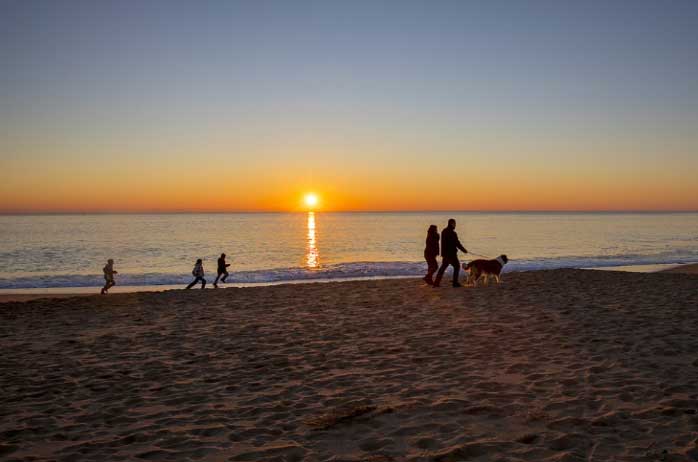
Here are some ideas you should consider:
- Buy a daylight bulb and give yourself a daily dose of light therapy. SADA, the charity set up for SAD sufferers, estimates that up to 85% could be helped with this simple therapy.
Interestingly, we bought one and use it in the office at home and our two cats fight over it as soon as it’s on. They obviously pick up on something! - Start some form of regular exercise, even simple yoga will help. Exercise is PROVEN to make you feel better.
- Avoid bad news. We are addicted to the news, which is mostly bad news. Health experts' advice is don’t read newspapers and don’t watch the news for this very reason. ( And it’s a factor in the mental health epidemic we see now) Our body systems were never designed to be bombarded with constant negativity. Try it! I guarantee if it’s something important, someone will tell you anyway. The rest, by definition, is not important.
- Spend time with friends. Studies have shown that THE single most important factor in life expectancy is having regular contact with close friends.
- Laugh a lot. Do fun things.
- Eat and drink sensibly
- Get as much light as possible.
It is perhaps alarming that Roman physicians identified all these factors 2,000 years ago and yet we are still trying to get the same message across now.
Whatever happened to common sense?
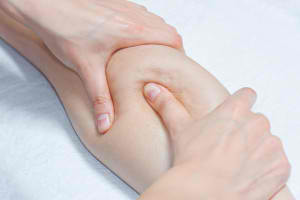
Why should you choose a sports massage near you?
Finding a good sports massage near you can be challenging; sometimes, it can be worth travelling just that little bit further. But how far should you travel? Well, that depends on you, what you consider a fair distance for the type of relief and benefit that you will get from a sports massage.
Some of our clients will travel from London and others around an hour, while many are happier to travel 30-40mins. Even 30-40mins will give a large catchment for Nicky Snazell's Pain Relief Clinic, which is based on Stafford, but we service areas like Litchfield, Cannock, Rugeley and Uttoxeter.
If, however, you believe that you might have a sports injury, then please visit our sports injury page and contact us.
What are the main benefits of a sports massage?
The benefits include improved recovery time and improved blood flow to joints and extremities. This means that you will recover more quickly than without.
How painful is a sports massage?
A sports massage can be slightly more painful than a regular massage, but it is important to note the strength of the massage is driven by the individual and the individual needs of the client. It can be driven by the type of activity, and your pain threshold.
How long does a sports massage last?
A sports massage can last up to an hour with us, but you can still see the benefits of a shorter session.
What happens after a sports massage?
We encourage you to keep moving but not to overdo it. Try and relax and let your body heal for a couple of days if you can. However, advice will vary for each patient, situation, age and health.
How long are you sore after a sports massage?
It will depend if you were exercising, the level of exercise you were performing, your age and your health. In most cases, recovery can range from 2-4 days, and this is normal. If you ran a marathon or raced, perhaps had a tough match, it could, of course, be longer.
Why does it hurt after a sports massage?
It can hurt after a sports massage as this is a more aggressive pressure around key muscles. It can make the surrounding tissue tender and enhance your aches for a shorter period. a sports massage is there to help release your muscles, tendons and joints to promote recovery and muscle conditioning. This process can all add to some soreness after a massage.
If you are looking for a physiotherapy clinic, visit this article to see how you can choose one, or if you are looking for physiotherapists, go to our home page and message or call our team.
“Mr Roo referred me to you, said you are the clinic of last resort, as you fix problems others don’t or can’t, and he knows you will listen to me.
“I love my grandkids. I love my garden, I love to feed to birds, the hedgehogs, it’s my world, my life. Right now, I can’t do any of this because it’s agony and I don’t have a life.
I get phone calls from my doctor who prescribes drugs that don’t work. I have just seen a private surgeon at £19 a minute. He didn’t listen to me. I wanted help, I wanted him to listen, I wanted to know what I could do, who I should see. He just said nothing could be done with total disinterest, that surgery at my age was a waste of time and so was physiotherapy.”
Isn’t this sad? No one listened, no one gave her any hope.
“I have a scan, here, look, I don’t understand what it means. Can you help.”
This is what we did…………………
The scan showed a narrowing in a disc and some of it had squashed out like toothpaste, crushing a nerve in a rather arthritic little spinal joint. This little tiny part of her back meant she couldn’t pick up her grandkids, walk far, sleep or bend over gardening.
A detailed assessment showed us where the physical problem was, her general fitness and how she moved (her biomechanics). We needed to gently open up her locked-down spinal joint, quell the inflammation in her disc, and release the muscle contracture trapping the nerve.
Just as important as the physical treatment, we also needed to explain how other aspects of her health and mental stress were affecting her and her pain. To do this we explained the 4 Keys to Health: mindset, fitness, food and lifestyle and how a simple red, amber, green traffic light approach could help guide her to take the positive steps to better health. This in turn would help protect her from COVID and her pain.
We gave the patient her life back
After just 3 sessions she was no longer in physical pain and perhaps more importantly, had got her life back, comfortable in the knowledge that she had been listened to and that what was important to her had been understood. In her sessions, we gave:
- Advice on the relevant keys and how to move to 4 green keys.
- Counselling to reduce stress/ improve the immune response
- Laser to ease the pain and help reduce the inflammation.
- Electroacupuncture to reduce the pain and inflammation
- IMS dry needling to cut through fascia and remove muscle contracture, taking pressure off the nerves
- Exercise to help reduce the disc bulge with specific manual mobilisations and robotics
- Deep oscillation massage to soothingly reduce inflammation further
- Gentle hands on healing to further boost the response
If you are in pain, we can help
Call 01889 881488 Now
Jean, Erica & Charlotte will be happy to help
